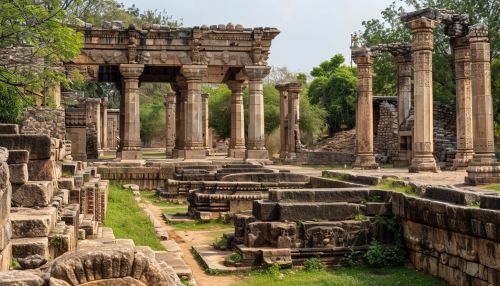Kakatiya Dynasty
History
The Kakatiya Dynasty was a South Indian dynasty that ruled most of the eastern Deccan region comprising present-day Telangana and Andhra Pradesh, with Warangal as its capital. The dynasty rose to prominence during the 12th and 13th centuries and played a significant role in shaping the history and culture of the region.
The origins of the Kakatiya Dynasty can be traced back to the 10th century when they served as feudatories to the Rashtrakutas and later the Western Chalukyas. The earliest known ruler of the dynasty was Venna, who is mentioned in the Mangallu grant of the Rashtrakuta king Krishna III. The dynasty's fortunes changed under the leadership of Prola II, who declared independence from the Western Chalukyas and established the Kakatiya sovereignty.


Political Structure and Administration
The Kakatiya administration was highly organized and efficient. The kingdom was divided into several administrative units called "Nadus," which were further subdivided into smaller units known as "Kottams" or "Sthalas." Each administrative unit was governed by officials appointed by the king. The central administration was headed by the king, who was assisted by a council of ministers.
The Kakatiya rulers implemented a well-structured revenue system. Land revenue was the primary source of income, and it was collected based on the fertility and productivity of the land. The Kakatiyas also maintained a standing army, which was crucial for defending the kingdom and expanding its territories.
Economy
The economy of the Kakatiya Dynasty was predominantly agrarian, with agriculture being the mainstay of the kingdom. The fertile plains of the Godavari and Krishna rivers provided ideal conditions for the cultivation of various crops, including rice, cotton, and pulses. The Kakatiyas also promoted irrigation through the construction of tanks and canals, which significantly boosted agricultural productivity.
Trade and commerce flourished under the Kakatiya rule. The kingdom's strategic location facilitated trade with other regions, including the Tamil kingdoms to the south and the northern Indian states. The Kakatiyas minted their own coins, which were widely circulated and accepted in trade transactions.
Society and Culture
The society of the Kakatiya period was characterized by a hierarchical structure with the king at the apex, followed by nobles, warriors, and commoners. The Kakatiyas were patrons of art, literature, and architecture. They constructed numerous temples, forts, and other architectural marvels that stand as a testament to their artistic and engineering prowess.
The most notable architectural achievement of the Kakatiya Dynasty is the Warangal Fort, which features impressive stone gateways known as "Kakatiya Kala Thoranam." The Thousand Pillar Temple in Hanamkonda is another significant monument that showcases the intricate craftsmanship of the Kakatiya artisans.
The Kakatiyas also promoted literature and learning. The Telugu language and literature flourished during their reign, with several notable poets and scholars emerging from this period. The Kakatiya rulers themselves were known to be learned and cultured, often engaging in literary and scholarly pursuits.
Religion
The Kakatiya Dynasty was predominantly Hindu, and the rulers were devout followers of Shaivism. They built numerous temples dedicated to Lord Shiva, which served as centers of religious and cultural activities. The Kakatiyas also showed tolerance towards other religions, including Jainism and Buddhism, and provided patronage to their followers.
The temples constructed during the Kakatiya period are known for their unique architectural style, which blends elements of Dravidian and Nagara architecture. The temples were not only places of worship but also served as centers of social and economic activities, playing a crucial role in the community's daily life.
Decline and Legacy
The decline of the Kakatiya Dynasty began in the early 14th century with the invasion of the Delhi Sultanate. The Kakatiya ruler Prataparudra II faced multiple invasions by the forces of Alauddin Khilji and later Muhammad bin Tughluq. Despite his valiant efforts, Prataparudra II was eventually captured, and the Kakatiya kingdom fell to the Delhi Sultanate in 1323 CE.
The legacy of the Kakatiya Dynasty endures in the form of their architectural and cultural contributions. The temples, forts, and other monuments built during their reign continue to attract scholars, historians, and tourists. The Kakatiyas also played a crucial role in the development of the Telugu language and literature, leaving an indelible mark on the region's cultural heritage.
